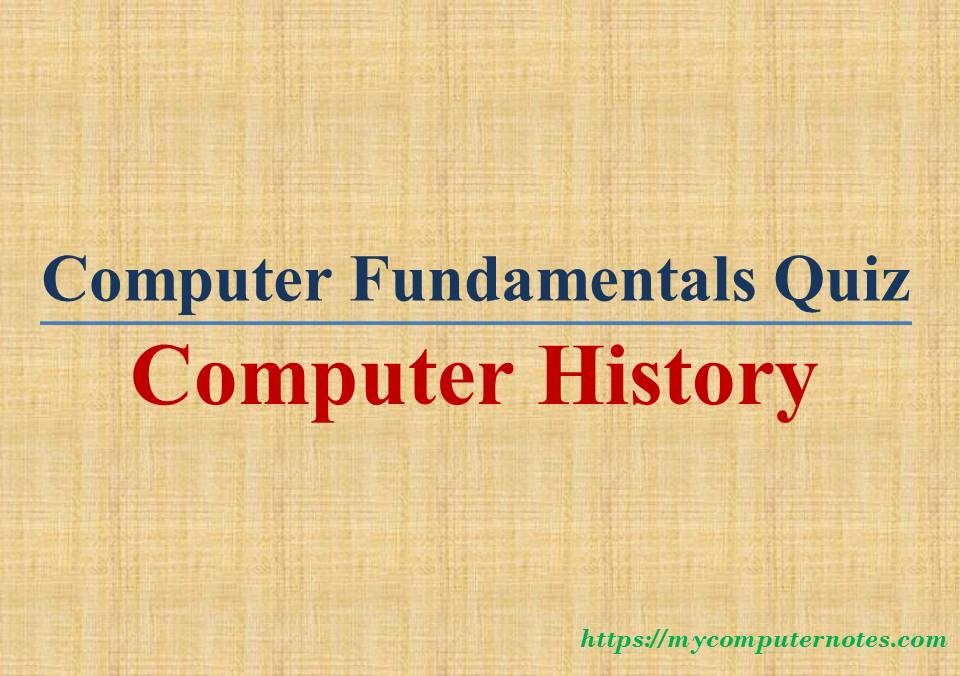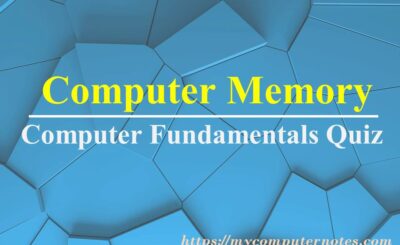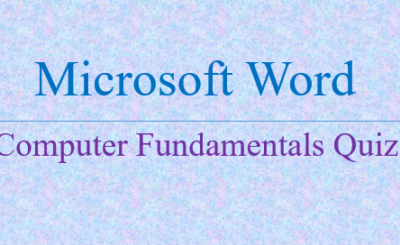| ← Prev | Next → |
 This MCQ section contains the Computer fundamentals quiz – Computer History. You can test your IQ on the computer history. Each question is a multiple-choice type with a single answer. The section consists of 20 questions with multiple-choice options.
This MCQ section contains the Computer fundamentals quiz – Computer History. You can test your IQ on the computer history. Each question is a multiple-choice type with a single answer. The section consists of 20 questions with multiple-choice options.
Each question is provided with the correct answer and an explanation for the correct answer. Click on the button named “Answer” just below the question to view the answer and the explanation. You can hide the answer and the explanation by re-clicking the “Answer” button.
Computer Fundamentals Quiz – Computer History
|
1. The analytical engine was considered to be the world’s first general-purpose computer. It was proposed by __________ .
Answer: Option A Explanation: The Analytical Engine was considered to be the world’s first general-purpose mechanical computer. It was designed and developed by the English mathematician Sir Charles Babbage in the 19th century. Charles Babbage is best renowned as the “Father of Computer“.
|
|
2. The person behind the first computer program that was developed for the analytical engine to calculate the numbers is _________.
Answer: Option A Explanation: Augusta Ada Lovelace is known as the first computer programmer. She was the daughter of famous English poet Lord Byron. She wrote an algorithm for the analytical engine.
|
|
3. The first fully electronic programmable computer was invented by ______.
Answer: Option B Explanation: Konrad Zuse was a German computer scientist. He invented the world’s fully programmable computer Z3 in 1943.
|
|
4. The first generation computer had used ____________ as the major hardware components.
Answer: Option D Explanation: Vacuum tubes were used as the switching device for the first generation computers.
|
5. Which of the following supercomputer is invented by the Indians?
Answer: Option B Explanation: Param is the first supercomputer designed and assembled by C-DAC Pune, India in 1991. C-DAC stands for Centre for Development of Advanced Computing Technology.
|
6. Which one of the following was the first top-secret computer made by British scientists that helped to break the German secret code during World War II?
Answer: Option D Explanation: Colossus was developed during World War II by a British scientist. The Colossus had helped to decipher the German secret code during World War II.
|
7. The punched card was invented by _______.
Answer: Option D Explanation: The punched card is a piece of the card made up of paper. The holes are punched on the cards to represent instructions and data. It was first invented by Joseph Jacquard in early 1725.
|
|
8. The acronym for EDSAC is
Answer: Option A Explanation: EDSAC stands for Electronic Delay Storage Automatic Calculator. It was originally developed University of Cambridge Mathematical Laboratory in 1949.
|
9. The Analytical Engine was developed during the First generation of the computer that uses _________ as memory.
Answer: Option D Explanation: The counter wheel was used as the main memory in the Analytical Engine.
|
10. Abacus came into existence long before 5000 BC. In which country, it has been introduced first?
Answer: Option B Explanation: The abacus is the ancient mechanical calculator for adding and subtracting numbers and it is still in use today for teaching arithmetic functions like addition and subtraction to young children. It was thought to be originated in China long before 500BC.
|
|
11. _____________ was used by Joseph Jacquard to control the operation of his loom.
Answer: Option C Explanation: Punch card is a paper card with holes on it to store data. It was used by Joseph Jacquard to control his loom operation.
|
|
12. Which of the following devices are used to control the operation of second-generation computers?
Answer: Option A Explanation: Transistor is a semiconductor switching device invented during the second generation of computers. It is more reliable, lighter, and cheaper than the first-generation vacuum tubes. It consumes less power and generates very little heat.
|
13.Which of the following device was invented by William Oughtred? The device was used for logarithmic calculation.
Answer: Option B Explanation: William Oughtred was an English mathematician who invented the slide rule during the early 1620s. Slide Rule was used for the logarithmic calculation.
|
14. Which of the following was Apple’s first graphical-based computer system?
Answer: Option A Explanation: Apple LISA was considered to be the First graphical computer launched by Apple Computer Inc. during the early 1980s. LISA stands for Local Integrated Software Architecture.
|
|
15. Step reckoner is considered to be the first calculator that can perform all the arithmatic calculations during the early 1670s. Who was the inventor of this device?
Answer: Option D Explanation: Gottfried Wilhelm Leibniz was a German mathematician who invented Step Reckoner during the early 1670s. Slide Rule was the first calculator that can perform all four arithmetic calculation
|
|
16. Which of the following was the first Microsoft Windows version to introduce the Start menu?
Answer: Option B Explanation: Windows 95 is a Windows 9x family operating system developed by Microsoft. It was launched by Microsoft on August 15, 1995.
|
17. Who invented the most commonly used pointing device in the personal computer, called a mouse?
Answer: Option C Explanation: The first generation computers are large in size, about the size of the room. They consume more power and also generate enormous heat. Because they use vacuum tubes as switching devices. However, transistors are semiconductor devices used in the second generation of computers.
|
|
18. Who first patented the QWERTY keyboard layout in 1878?
Answer: Option A Explanation: Douglas Carl Engelbart was an American Engineer. He is famous for the invention of mousing for GUI-based systems.
|
|
19. IBM 701 was considered to be IBM’s first scientific computer. In which year did it was introduced to the public?
Answer: Option B Explanation: IBM 701 was the electronic data processing system launched by IBM in 1952.
|
|
20. The man behind the creation of world-wide web(www) is ____________.
Answer: Option C Explanation: Sir Timothy John Berners-Lee is an English scientist. He invented the world wide web (WWW) in 1989.
|
| ← Prev | Next → |






